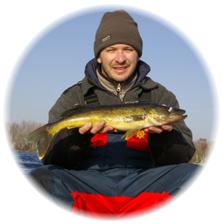By Justin Hoffman All of us have had tough days on the water - bad weather, equipment failure and fish that refuse to bite. Walleye fishing is often a game of chances, and when these fish shut down, you'll find yourself cursing all the way back to the launch ramp. There are a number of techniques and adaptations that anglers can use that can turn finicky fish into biters, and with practice and patience, you can turn that bad day into a good one, and fill that live well up to the limit in the process! Weather Conditions Weather plays a very important role in walleye activity, and a lack of optimum conditions will usually result in a sub-par day. Due to their light-sensitive eyes, a walleye will be most active during overcast days. They will also be more likely to roam and feed while the wind is blowing, as this causes wave action that breaks up sun penetration. Unfortunately for anglers, these variables are not always the most comfortable to fish in - they will, however, provide positive results. If you happen to be out, and the sun is shining and the winds are still, what should you do to ensure that you get bit? If you happen to be fishing a shallow, fertile lake, then your best course of action is to search out the lushest, greenest weeds available and present a jig to the walleye that will be seeking shade and cover underneath. Slow, methodical lifts of a bucktail or twistertail will do the trick, and the addition of a minnow or worm may coax the inactive walleye to become more co-operative. If you are fishing a deep northern shield lake, then your best bet is to fish deeper, while keying-in on productive structure areas. Searching out breaklines and drop-offs and jigging the area thoroughly, or running a live-bait rig or bottom bouncer, will do the trick. A key to remember is this - the more miserable the weather, the faster the retrieve. Sunny, beautiful days call for a slower presentation and added searching to find those inactive fish. Locations It is common knowledge that walleye are fish that relate to the bottom structure and will be found hugging the lower part of the water column the majority of the time. This is true in most cases, but there are times when walleye will suspend mid-way through the water column. Walleye are feeding machines, and will follow baitfish when actively feeding. If the resident baitfish are ten feet from bottom, then the opportunistic walleye will be close at hand. I have spent time with other anglers that refuse to do anything other that jig on bottom for fish, regardless of whether they are getting bit or not. Experimentation is the key, and jigging a spoon (similar to ice fishing) at different depths, or trying different models of diving crankbaits will connect you to fish quicker. Many of the better-quality fish finders will display baitfish schools on their screens. My most effective technique when I come across this while running a lake, is to throw out a marker buoy to mark the baitfish, then drift back over the area with the above mentioned lures. It is a different dimension to walleye angling that is worth trying when the fishing becomes fruitless. Be Versatile One of the biggest mistakes a walleye angler can make is to stick to a technique when it isn't working. Changing things up are key to putting more fish in the boat, and essential in turning "sniffers" into "biters." When out on the water, make sure that you carry a large assortment of crankbaits. Be sure to include different colour combinations and in varying weights and sizes in order to test what the walleye wants that particular day. There have been days out on the water when the only colour that the walleye would show any interest in was red, and if you had the misfortune of not owning any cranks in that particular colour, then your day was a disaster. If there is more than one person in the boat while trolling, it is best to run completely opposite crankbaits. Troll with different colour combinations, shapes and sizes, in order to see what the fish prefer. If one angler has a run of two or more fish in a row, then you have stumbled upon a pattern, and at this point it is best to change over to match their lure. Relying on live bait is not always the best option. Although many may believe this statement is false, there are times when livebait will hinder your fishing. An example of this occurred during the season opener of this year on one of the Kawartha lakes. My fishing partner and I were slow trolling a crankbait and a worm rig. Attached to his spinner rig was a fat, juicy nightcrawler. Although he was hooking into numerous rock bass and perch, the walleye were just not co-operating. I, on the other hand, had two fish in the livewell that came on the crank. He then decided to do the unthinkable and removed the crawler while replacing it with a plastic worm in a motor oil colour. Two trolling passes later and he had two fish in the well, and ultimately figured out what the resident walleye were looking for that day. Experiment with different lures and techniques until you find that one that works best under the conditions that you are faced with. Walleye fishing is a tough game to play at times, yet the resourceful and smart angler will always figure the puzzle out. Pay attention to details while out on the water and don't be afraid to try something new - the results might just surprise you! Back to Front Page of Magazine
Get North!
Fishing
Lodge Classifieds |


